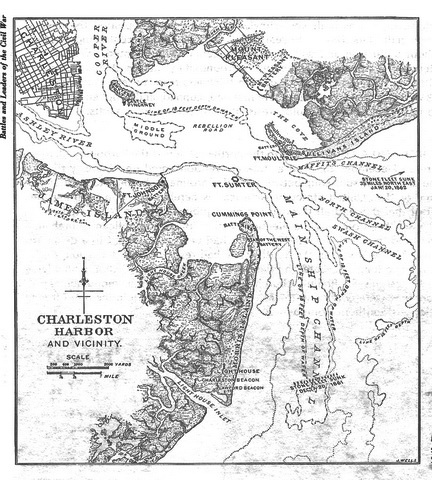 |
| Charleston Harbor Defenses from Battles & Leaders of the Civil War |
|
ISSUE NUMBER 8 |
HISTORICAL MINIATURES BY GEORGE GRASSE |
MAY 2010 |
HISTORICAL MINIATURES JOURNAL ISSUE NUMBER 8
PUBLISHED BY GEORGE GRASSE
|
PHOTO TOUR OF THE CHARLESTON HARBOR DEFENSES 1864 |
By George Grasse
 |
| Charleston Harbor Defenses from Battles & Leaders of the Civil War |
 |
| CHARLESTON WATERFRONT TODAY: This photo was taken from the Fort Sumter tour boat leaving the Charleston waterfront behind. |
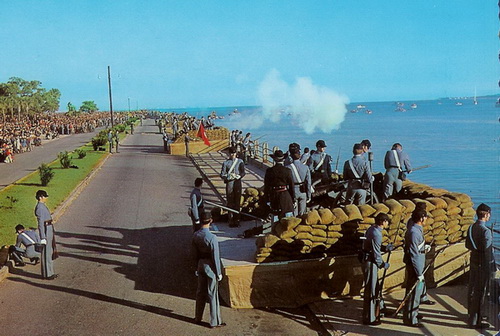 |
| CHARLESTON WATERFRONT RE-ENACTMENT: This photo is one I did not take. It is from a postcard showing a large-scale re-enactment of what the waterfront artillery defenses might have looked like. Soldiers manning the artillery are Citadel Cadets. |
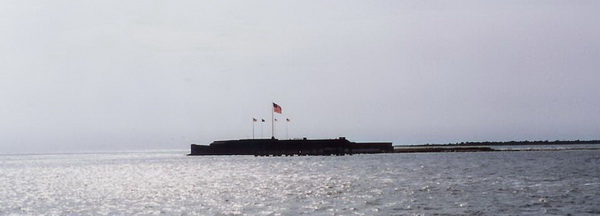 |
| CHARLESTON HARBOR DEFENSES: This is the view from the harbor tour boat as you approach Fort Sumter. The fort is situated on a shallow ledge projecting out into the harbor. The darker tree line in the distance is Morris Island on which were located substantial emplacements including Fort Wagner, now underwater. This view is looking southeast out to the Atlantic Ocean. |
 |
| FORT SUMTER PLAN VIEW: This diagram is taken from the National Park Service brochure. 1) sally port; 2) left flank casemate; 3) enlisted men's barracks; 4) officer's quarters; 5) parade ground; 6) left face; 7) right face; 8) right gorge angle (from this position, Doubleday returned fire); 9) position of Confederate mountain howitzer guarding against surprise landing; 10) esplanade. Shaded area shaded in dark gray is a modern build-up known as Battery Huger and is as high as the original walls. The light gray area is slightly lower, also modern. Fort construction started in 1829 and was essentially completed by 1861. |
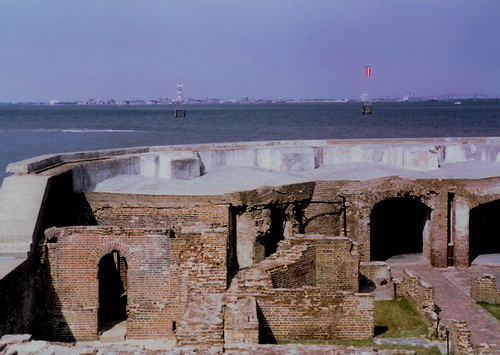 |
| FORT SUMTER CORNER OF THE LEFT FLANK CASEMATE AND LEFT FLANK FACE: This view is to the northeast. The large square wall with tall rounded entry is the northeast corner of the enlisted men's barracks. Casemates of the left flank face go off to the right. Heavy guns were mounted in these casemates and on top. The guns would be firing at any ships that present their broadside to the fort as they enter the harbor. Fort Moultrie lies just opposite (cannot be discerned in this view) and contributed to an effective cross-fire. |
 |
 |
| CASEMATES RELATIVELY UNDAMAGED | CASEMATES VIRTUALLY DESTROYED |
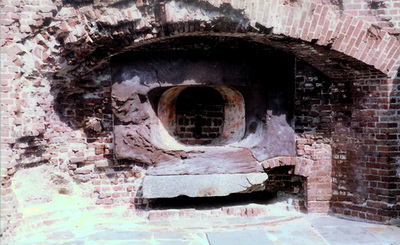 |
| FORT SUMTER CASEMATE GUN APERTURE: This aperture of a destroyed casemate has been bricked to prevent visitor's from falling. A large gun would have been mounted on a wheeled carriage so it could traverse the narrow opening which is widened at an angle on the inside on either side of the aperture. |
 |
| FORT SUMTER 10-INCH COLUMBIAD SMOOTH BORE GUNS: Guns of this size were necessary in order to reach distant targets with large destructive solid shot. The fort would also be armed with a variety of rifled guns which could engage targets at even greater range with relatively effective shell-bursting capability. |
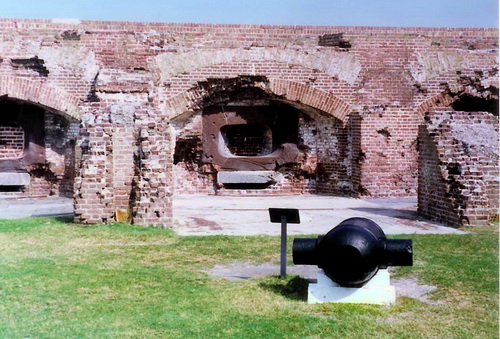 |
| FORT SUMTER CASEMATE AND HEAVY MORTAR: Another type of artillery piece used to defend against ships was the heavy mortar which could lob an 8- or 10-inch explosive shell at a high angle to as to strike a ship from directly above. Although not as accurate as a flat trajectory weapon, a hit of this size would usually plow through the decks of a ship and explode below the waterline or even penetrate the hull. The cement pad just behind the seaward side of the casemate marks the position of the inside arch which originally supported a thick brick roof to protect the gun crew. Powerful guns of the American Civil War, especially the large rifled pieces, brought an end to brick masonry fort construction. |
 |
| FORT SUMTER VIEW FROM THE ESPLANADE: Morris Island lies dead ahead. All of the area on Morris Island that once supported Fort Wagner is now underwater. That fort and one farther south and another towards the inner harbor off to the right prevented Union forces from erecting their own forts which could bombard Fort Sumter from the rear. The esplanade was designed to protect Fort Sumter from a seaborne landing. Light field guns such as shown on the shore, were part of a "close-in" defense against landing craft loaded with infantry. These guns would have been protected by ordinary earthworks no longer visible. Morris Island was eventually taken by Union forces which caused most of the damage seen today. |
 |
| FORT SUMTER AERIAL VIEW: This photo is credited to the National Park Service and appears in their booklet "Fort Moultrie". The large center structure in the main fort is the World War II - era "Battery Huger" that mounted modern guns capable of penetrating armored warships. The physical remains of the American Civil War - era "Fort Sumter" on on the left. |
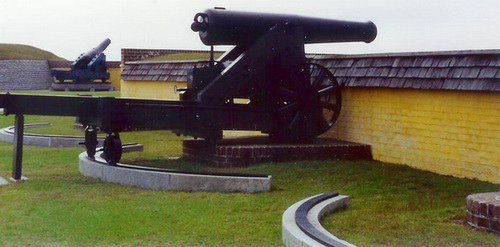 |
| FORT MOULTRIE GARRISON GUN: This type of gun carriage was typical for the American Civil War period. When fired, the gun on a small carriage on top of the main carriage recoiled to the rear. It would have to be loaded and then "run up" to its firing position, re-sighted, and fired. To traverse the gun, the small wheels on the rear of the main carriage accommodated movement left or right. An screw mechanism attached to the rear of the barrel and the gun's short carriage allowed for elevated fire. In this background is a large 10-inch seacoast howitzer (see next photo). |
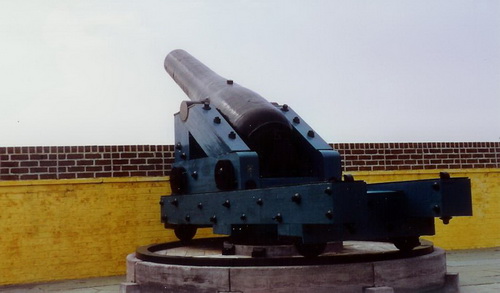 |
| FORT MOULTRIE SEACOAST HOWITZER: This is a third type of gun used in coastal defense. Its angle of fire between the relatively flat trajectory of a rifled or smooth bore gun such as the 10-inch Columbiad and the high trajectory of a seacoast mortar. It was usually sighted in the defense of land exposed to seaborne assault but could be effective against unarmored transports or landing craft. |
I TOOK THESE PHOTOS IN SEPTEMBER 1998
GO TO?